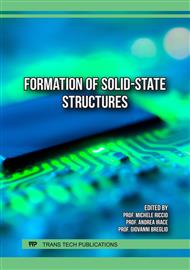p.29
p.35
p.41
p.47
p.53
p.59
p.65
p.71
p.79
Prediction of Contact Resistance of 4H–SiC by Machine Learning Using Optical Microscope Images after Laser Doping
Abstract:
In this study, machine learning (ML) was employed to predict the electrical properties of finished devices, specifically focusing on the state of the contacts at the electrodes. The predictions are based on optical microscope images of the surface conditions, which were captured immediately following the laser doping of nitrogen atoms into 4H-SiC. The laser doping process involved varying the laser fluence from 0.4 to 4.0 J/cm2 and using number of laser irradiation to 5, 10, 20, and 100 shots. The ML prediction was carried out in two steps. In STEP1, we classified the contact status into three types.: 1) Schottky junctions (insufficient doping), 2) Ohmic contact (good contact), and 3) Not ohmic (damage caused by laser irradiation). In STEP2, contact resistance prediction (numerical regression) was performed using the dataset predicted as an ohmic contact. As a result, we found that the three classifications in STEP1 could be predicted with a high accuracy of over 88%. Furthermore, the contact resistance prediction in STEP2 could be made with an accuracy (RMSPE: root mean square percent error) of 27.2%. Visualizing the prediction basis of numerical regression using modulus-reweighted grad-regression activation mapping (MoRAM) revealed that the ML model focused on the inside of the laser-irradiated area in the optical microscope image. The results of the scanning electron microscopy observation of the laser-irradiated area showed that ablation and residuals were generated during laser doping in that area. Consequently, it was concluded that our ML model predicted the contact resistance of the finished device taking into consideration these surface conditions. Even highly-skilled laser doping technicians have difficulty predicting the resistance values arising from the ablation and residue conditions. Based on above results, we conclude that our ML model is capable of predicting the electrical characteristics of a finished device, a task that is often considered challenging for humans.
Info:
Periodical:
Pages:
53-58
Citation:
Online since:
August 2024
Permissions:
Share:
Citation:


